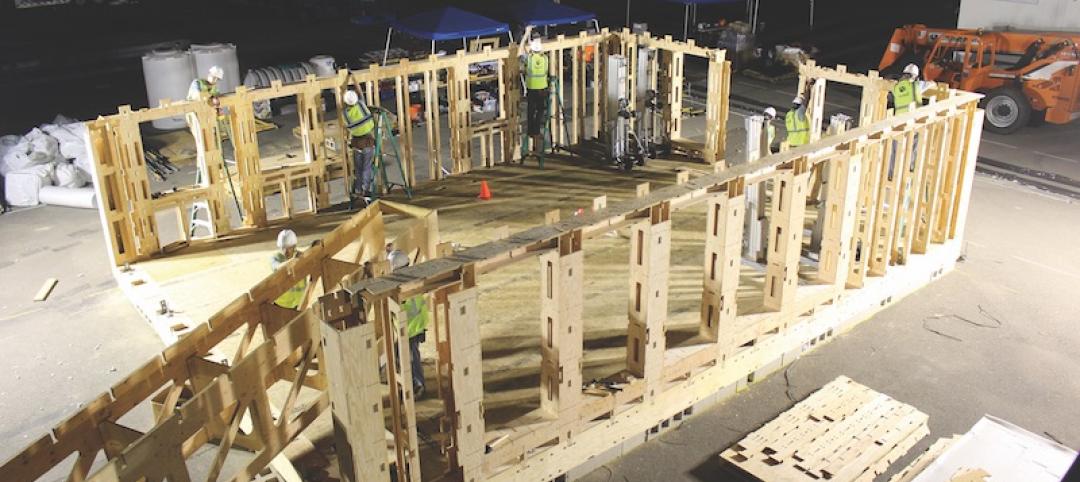If you took a poll of building envelope and construction forensic experts, it's likely that moisture barriers would be high on the list of most poorly understood products used in wall assemblies. Besides deciding which type of barrier to use under various climate conditions, Building Teams must confront the nasty matter of how to install them correctly.
To shed some light on this nettlesome problem, we called upon Richard Robison, RA, CCS, NCARB, a principal at Lord, Aeck & Sargent, Atlanta, and a nationally recognized expert in construction specifications. In 2002 he was awarded the Construction Specifications Institute's Ben John Small Memorial Award for special proficiency and outstanding stature as a practicing specifier. He is a member of the AIA, CSI, the Southern Building Code Congress International, the Association for Preservation Technology International, the Masonry Society, and the American Society for Testing and Materials.
1 Understand the basic types of membrane primers and when each should be used.
Twenty years ago, when the first generation of so-called peel-and-stick membranes came out, rarely did they live up to their name. “They'd blow off with any wind pressure,” says Robison. Since then, manufacturers have developed primers to bond the “self-adhesive” sheets to the surface of the wall.
 |
| Mockup for a wall assembly for a new residence hall at Columbia Theological Seminary, Decatur, Ga. Building envelope expert Richard Robisonsays a standalone mockup like this should run about $10,000 in total costs but will save time and improve quality for the project. |
There are basically three kinds of primers: cutback asphalt, surface conditioners, and glues. Cutback asphalt is used primarily in colder climates, especially when the peel-and-stick is being applied when the temperature is below 40°F (something Robison stresses should be avoided if at all possible). Cutback asphalt is also used when VOCs are not a major concern, although there are water-based versions with low VOC ratings that could be used in projects seeking LEED or other green certification.
Surface conditioners are sealants that basically consolidate dust and close up the pores on the surface of the wall. “I'm not a particular fan of them because I don't think they have as good adhesion as other sealants,” says Robison. There are surface conditioners for use with concrete and masonry, another for plywood, and a third type for fiberglass-faced sheathing products. Surface conditioners should not be used when the temperature is below 40°F, he warns.
Glues can vary in their effectiveness, says Robison. “A lot depends on the reputation of the manufacturer and your own experience,” he says. “If the glue is working well and the phone isn't ringing, that's great, but if the membrane is curling or bubbling, it could look like a Laurel and Hardy comedy on the job site.” Again, don't use glue when it's below 40°F outside.
2 Firmly roll every square inch of transition membrane.
“It's of particular importance to roll every inch of the surface with a small roller, pressing the sheet into the primer and the substrate, and to keep going back and forth over the entire sheet—that point cannot be overestimated,” cautions Robison. He recommends installers use a four-inch-wide roller with a small handle. “It's laborious, it takes muscle, it's time-consuming, and it seldom gets done fully and properly,” laments Robison.
3 Be aware of special concerns about spray- and roller-applied weather barriers.
Over the last decade or so, manufacturers have come out with liquid-applied weather barriers. These barriers prevent the passage of air and liquid water and, depending on the formula chosen, they can be either vapor-permeable so as to allow moisture in the walls to dry in both directions, or they can be barriers to vaporous water as well. They are used in the field of the wall along with a peel-and-stick transition membrane at door, window, and louver openings—in fact, anywhere the wall system changes from one substrate to another. The liquids are rolled on with a paint roller or sprayed onto the wall.
Robison says these liquid-based systems have several advantages over peel-and-stick alone: 1) greater productivity, because there's no hand pressing, 2) greater adhesion, because the liquid can soak in and adhere well to the substrate under most conditions; and 3) after installation, you have either a vapor barrier or vapor-permeable membrane in service (depending on the liquid formula best suited for the project location; peel-and-sticks on the other hand are nearly always vapor barriers).
But there's a downside to using a spray system—the cost of buying or renting the equipment and keeping it cleaned and maintained.
Also, says Robison, you have to sequence the job correctly or you'll run into overspray problems. For example, you don't want to spray the windows, or any materials or equipment (such as a truck) underneath the spraying area. This is one reason why most installers prefer to roll the liquid on, rather than spraying it—there's just less risk of messing up.
Lastly, you need to be aware that manufacturers of liquid products have different formulas and application methods, which can affect the thickness of the final coat. Some use a two-component system, others a single-component material. Some require heat in the spray apparatus. Some are 100% solids content (liquids that undergo chemical change into a solid without losing solvents or volume in the process), so when your installer applies 60 mils of wet thickness, you end up with a 60-mil dry thickness on the wall; others are 50-75% solids, and 60 mils of wet thickness may only get you 45 mils of dry coating.
Controlling the mil thickness also depends heavily on the skill of the installer. “With some products you can easily see where it's too thin, but with some other products the color makes it hard to get a sense of the thickness,” says Robison.
There's even a difference of opinion as to how thick the membrane layer needs to be. Some manufacturers want it to be in the 45-60 mil range, some allow as little as 7-8 mils dry, while others say that as long as the membrane is continuous without pinholes or holidays there can be some variation in the thickness.
4 Build a mockup of the wall assembly.
“Construction detailing is so complex today, with so many trades focused on this one element, I recommend building a mockup on every project,” says Robison. “My experience with contractors, going back 35 years, is that if you tell them what you want, they will do it willingly, but not if you tell them after the fact.”
Robison says having a mockup invariably saves time and money in the long run. “Ten thousand dollars should buy you a foundation, the backup structural wall, the windows, the cladding, the weather barrier and its insulation, and the time of the people to build the mockup and evaluate it,” he says.
“Some owners and contractors see this as an extra cost. My feeling is this is penny-wise and pound-foolish. The various installers will be more productive on the entire job, and there will be fewer or no callbacks to plague the owner.”
One side note: Build the mockup separate from the structure itself. With a self-standing mockup, says Robison, you can play around with it and nobody cares; if it's part of the actual wall assembly, the temptation is to not mess with it, which defeats the whole purpose. Also, a standalone mockup is always there as a reference for the trades to check their work against.
5 Try to use sealing products from a single manufacturer, or at least products that are as compatible as possible.
In any wall assembly, you're going to have many different building products—perhaps a vinyl window, a steel lintel, metal panels, stone, brick, CMU, sheathing, insulation—each with its preferred method of protection against the weather, possibly each being installed by a different subcontractor. For the weather barrier you might have a peel-and-stick product for the through-wall flashing and a different peel-and-stick for use with the liquid barrier. Needless to say, making these disparate materials and products come together as a well-integrated wall assembly requires considerable knowledge, skill, and coordination.
At least for the weather barrier Robison recommends using a single manufacturer's products as much as possible. “The self-adhesive flashing and liquid-applied membrane need to be compatible,” he says. “But the weather barrier manufacturer's recommendations may be at variance with the window manufacturer's recommendations. You need to coordinate and resolve any disagreement.”
6 Follow the manufacturer's installation instructions, but keep your eyes wide open.
“Install in accordance with manufacturer's instructions” should be routine practice, but it is, sadly, a custom more honored in the breach than the observance. “These are all proprietary products, the formulas are different, although similar, and each manufacturer will have similar but slightly different installation instructions,” warns Robison.
For example, some manufacturers or independent consultants want you to use termination bars (metal strips used to support the sheet membrane) at the top of the window, others say do so on all four sides, and still others say you don't need termination bars at all. You have to use your best judgment and make your own decision.
The same goes for edge mastic, says Robison. Some weather barrier makers recommend using a slight bead on all edges of the membrane, even at lapped edges, while others do not require mastic at all. And some manufacturers recommend using a urethane caulk in one situation and asphaltic mastic in another.
Be aware, too, that certain manufacturers suggest various “levels” of installation—good, better, best—for their products. And for some manufacturers, says Robison, “their installation instructions are less than worthless, they have no tech support in the field, and all they sell is a product.” Which brings us to our next bit of advice.
7 Take advantage of the manufacturers' expertise.
“Get the manufacturers' technical representatives on the job site, consulting with you and the installer and reviewing the mockup,” says Robison. He says the major manufacturers are more than willing to do this, especially with a newly introduced product.
“I rely on good relationships with product manufacturers to achieve a comfort level,” says Robison. He recommends talking to the technical representative, product director, or product manager. “I can tell very quickly whether I'm talking with a sales guy or with someone who knows more about the technology than I do.”
The last word from this veteran of 35 years in the field: “Make sure the installers understand what you're after, and that you understand what they intend to do,” says Robison. “They'll do as you ask, as long as they know what you want.”
Related Stories
Great Solutions | May 5, 2017
No nails necessary: Framing system comes together with steel zip ties and screws
Clemson University’s School of Architecture develops a patent-pending construction method that is gaining attention for its potential use in rapid, low-tech sustainable housing.
Building Technology | May 5, 2017
Tips for designing and building with bathroom pods
Advancements in building technology and ongoing concerns about labor shortages make prefabrication options such as bathrooms pods primed for an awakening.
Building Technology | Apr 21, 2017
AIA selects 2016 Upjohn Research Initiative Projects
Grants awarded to initiatives that study various aspects of design within the built environment.
Building Technology | Mar 9, 2017
Prefabrication's predicament: It's much harder than it looks
Many of the nation’s largest contractors, including Gilbane, Mortensen, Skanska, and Turner, have been utilizing prefab techniques on select projects for a decade or more.
Great Solutions | Mar 8, 2017
Pop-out balcony is a breath of fresh air for stuffy hotel rooms and apartments
In less than one minute, Bloomframe transforms from an insulated picture window to an open balcony.
Building Materials | Feb 15, 2017
New metamaterial cools roofs without any energy consumption
The material is barely thicker than aluminum foil and can be economically manufactured for large-scale residential and commercial applications.
Building Technology | Feb 13, 2017
Denver’s ‘smart neighborhood’ will be packed with futuristic technology
The neighborhood will become a test lab for innovative technology.
Virtual Reality | Feb 1, 2017
Tour ancient buildings and cities as they were when new with Lithodomos VR
An Australian archeological startup is bringing the ancient world to a VR headset near you.
Building Technology | Jan 30, 2017
Machine learning could help buildings notify occupants about critical systems failures before they happen
Data from sensors built into HVAC units paired with a machine learning algorithm predicted 76 out of 124 real faults for an Italian hospital.
Building Technology | Jan 27, 2017
The driverless clinic: How buildings powered by AI can help promote wellness and enhance human connections
In the future, we envision that the smart technology in our phones will be embedded in the items we wear and the objects we use.















